Amalgamation in Greater Victoria
Collage (L to R): (T) Langford, Sidney, Victoria, Saanich, Highlands,
(C) Esquimalt, (Malahat), (CRD) Oak Bay, Metchosin,
(B) Colwood, Sooke, North Saanich, Central Saanich, View Royal
(Link to Photo Album)
Link to a 2015 Research Summary on Police Force Size vs Cost/Efficiency
A Literature Review of the Amalgamation of Police Services in Canada
(This is a great summary for those wishing to learn more about whether the police in
Greater Victoria should be amalgamated)
Link to Next Post: Amalgamation in Greater Victoria: Questions and Answers
Link to Most Recent Post Directed at Young People: Local Communities: Keeping the Spirit Alive
The Real Costs of Amalgamation (Time Colonist November 23, 2014)
Note: By pure chance after writing Amalgamation: Question and Answer (link above) during a further search on the subject, an astounding discovery was made: The Bish Papers. These papers, written by a renowned Economist and researcher into Public Administration, stripped away the veil of opinion and conjecture that defined the debate on Amalgamation to this point in time. You may still wish to read this post and as well as the Questions and Answers, however the solid, reliable information comes from the papers written by Dr. Robert L. Bish. Link here to:
Amalgamation: A Search for the Truth
1. October 17, 2014: Introduction to Updated Post
The Capital Regional District: With thirteen members spread over 2,340 km² the CRD is roughly three times the size of Calgary, and somewhat larger than the 1,800 km² GTA (the Amalgamated Six in Toronto). However, our population clearly considerably less.
The CRD (including the Malahat), situated in a secluded corner of the Pacific Northwest, has within its small spread of 593,o59 acres filled with mountains, inlets, bays, forests, farmland, as well as an ocean border and dozens of streams, rivers. and lakes. Almost every home in the region is situated no more than fifteen from long stretches of sun-kissed sand. Looking towards the eastern and southern horizons, you see snow capped 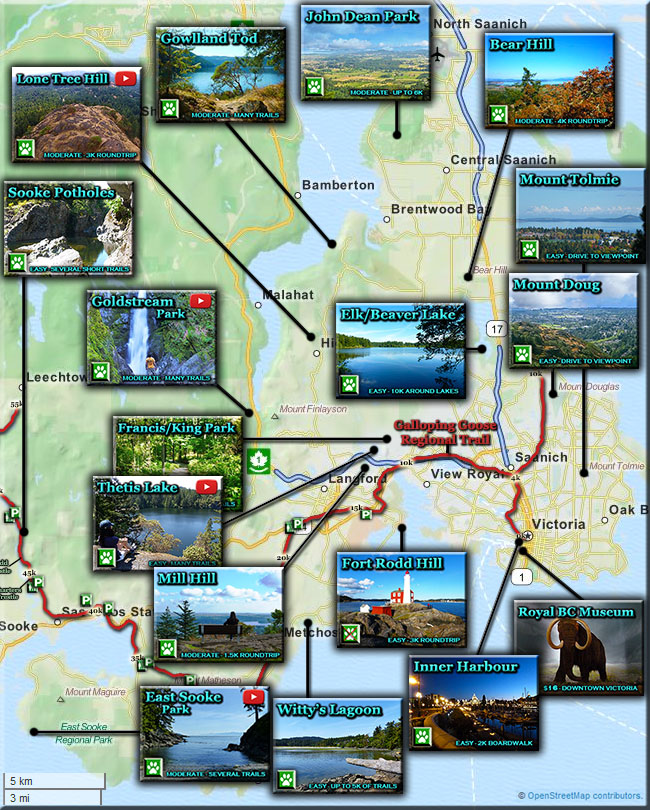 mountains and a sprinkling of smaller islands around which killer whales, sea lions, seals and salmon entertain tens of thousands of visitors each year.
mountains and a sprinkling of smaller islands around which killer whales, sea lions, seals and salmon entertain tens of thousands of visitors each year.
Trail Map: The CRD has a network parks connected by a seemingly endless series of hiking and biking trails that reach to every community from Oak Bay in the south to North Saanich, then west to Metchosin and Sooke. Because of the mild climate these parks and trails are heavily used year-long (double click to open the map).
The mild weather also draws large numbers of Canada’s top athletes to half dozen indoor and outdoor high-performance centers sprinkled across the region.
As part of the infrastructure, the CRD comes equipped with world-class hospitals, schools, colleges, universities, libraries, recreation and sports facilities, entertainment and shopping, virtually everything a growing family might desire, yet there is still plenty of room for singles and seniors who desire to become fully engaged in a healthy lifestyle. In a few words, the Capital Region is a pristine jewel in the Pacific Northwest that draws tourists and new residents from across Canada and around the world. Calgary also does that, but Oil Money is the game that draws the most people to Calgary.
All things being equal, it would be difficult to find anyone in the CRD who would rather live, raise a family or retire elsewhere in Canada. Yet, despite this abundance, one member of the CRD family is constantly agitating to change the governing and administrative structure. To accomplish this they would amalgamate some or all of the parts into one unit with the goal of achieving ‘economies of scale’ and ‘efficiency’. To provide some balance to their negative campaign, this article is being updated.
As you may have noticed by the number of signs now posted along our streets, Municipal elections will take place on November 15. Over the past few years the City of Victoria, it’s former Police Chief (the current Chief seems to have stepped back from the heated rhetoric that challenged his colleagues), Business Community, News Paper (Times Colonist) and a number of Victoria citizens (with apparent support by others) operating under various banners such as, Amalgamation Victoria, have pushed their CRD partners into putting some form of amalgamation question on the ballot.
To my knowledge, not one Mayor, council member or citizen group in any of the other twelve constituencies have voiced support of Victoria’s view, yet barely a week goes by that more articles appear in the Times Colonist complaining about overlapping services, waste and general disfunction within the region.
Never once has the Times Colonist printed an article outlining the amazing progress the partners in the CRD have made over the past several decades and of the many advantages gained by citizens in having smaller administrative units that place governance at their doorstep. Those smaller units create opportunities to develop their small part of the world in a manner desired by citizens who know their politicians and who know they can influence outcomes.
In speaking to the subject, I rather enjoyed a statement made by my nephew in a Facebook exchange we had some time back:
“Hmmm…I would think that the effects on community spirit and the like depend less on the size of the municipality and more on what people actually do for and with each other. The suggestion that amalgamation is the solution to municipaliti…es money and service problems misses the point that efficiency is a means, not an end. Also, efficiency pushers are addicted to this mission. For them, the government can never be efficient enough. After the amalgamation, they will see nothing but waste and continue to push for cuts. Service will deteriorate and that poor performance will be the new justification for further cuts, privatization, etc.” (Lorin Yochim)
We have all watched Toronto and other amalgamated cities over the past few decades and doubt anyone would wish those outcomes on our worst neighbour. Remember, there was a time when people firmly believed that what was good for General Motors was good for the world. The same might be said about the Ford world.
2. The Ongoing Debate
Beyond the self-serving statements made by Mayor Fortin (that amalgamation is “the ‘right’ thing for “our citizens”) could there be other considerations that deserve attention, but never see the light of day in the Times Colonist? The answer is most certainly ‘yes”.
First, concerns a ‘police only’ amalgamation. Given that the Victoria-Esquimalt police merger has raised such a firestorm of debate between just two of the thirteen CRD members, how might that debate play-out with three, four or all of the police agencies dumped into one melting pot and controlled by one board?
Next, involves the full or partial amalgamation of CRD members. Would the same developmental progress have been achieved by individual members if, over the past two or three decades, each had been controlled by a Metropolitan Government?
Finally, what is the experience of another jurisdiction in the Province that has twenty-one constituent parts and a population exceeding 2.2 million? Is it better off than Toronto?
Being fair-minded reporters, perhaps Jack Knox, Rob Shaw, Lindsay Kines, Katie DeRosa and a host of others, who have regularly spoken strongly for amalgamation, might set aside a few minutes to report on points that tend to favour the status quo? That is not likely to happen as evidenced by another article of Jack Knox appearing on October 8, 2014. In the article, Jack displays his usual bias in the first two sentences:
For those keeping score at home, eight of the 13 municipal councils here in Dysfunction-By-The-Water (my bold) have agreed to pose some sort of amalgamation question to their voters next month.
That’s “some sort” because Saanich has come up with wording that artfully avoids using the A-word: Do you think things are fine as they are, or should council ask itself whether things are swell? (Link to TC article)
I realize the world is divided into ‘glass half full” and “glass have empty’ types, but comments like the above suggest Jack’s glass is empty. I would love to take Jack, the Victoria Mayor and Police Chief, a few business persons and a sprinkling of Amalgamation Victoria supporters out to show them some of the amazing things being accomplished by the dysfunctional CRD partners of Victoria.
Given that will not likely happen, to help Jack and the Times Colonist reporters, as well as the others, broaden their narrow view of the world, alternative points are provided in this post. I rather expect that if one or more of the TC reporters decided to speak to these alternatives, many readers in the region would be most appreciative. After all, is it not the job of a fair-minded reporter to provide a balanced report on a subject they claim holds widespread interest?
Harold McNeill
October 17, 2014
3. Background: Present CRD Structure and Policing Contracts
Within the CRD, Victoria, the Provincial Capital, nestled in the southernmost core, is but one of a family of thirteen. In 2011, the regional population, from Sooke to North Saanich and points between, was estimated at 350,000. In terms of Canadian Provincial Capitals, the City of Victoria, with less than 80,000 citizens, is among the smallest with only Whitehorse, YT (26,418), Yellowknife, NWT (19,000), and Iqaluit, Nunavut (6,100), being smaller. While the ‘little city’ attitude in Victoria can be somewhat understood, attitude is not a good reason to push others into helping them become bigger. They need to focus on how they are great and play to those strengths.
Victoria, because of its unique advantage in being the Provincial Capital and an attraction for tourists that far exceeds other Canadian cities five or ten times their size, carries a big stick in the Regional District. The problem, they use that stick to beat the drums of amalgamation as being the only ‘fare way’ of helping Victoria cope with ‘core city problems.’ On many occasions, the Victoria Police Department, by beating the same drum, has alienated other police partners by suggesting Victoria are the ones doing the work while the others just ride their coattails. That attitude does not serve them or the city well.
The Capital Region
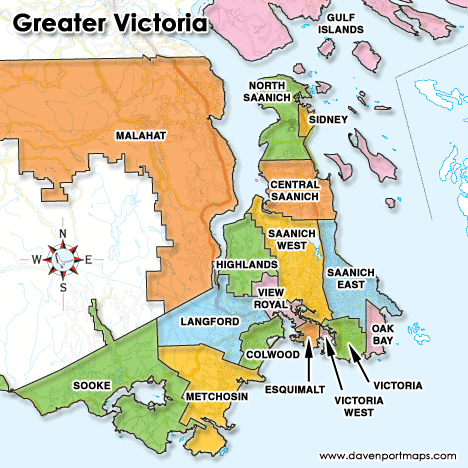
District Population and
Number of Sworn Police Officers
(2011 population figures at end of the article)
Saanich 108,000
Saanich Municipal Police (150)
Victoria (78,000) and Esquimalt (17,000)
Victoria-Esquimalt Police (241) 95,0002
Oak Bay 18,000
Oak Bay Municipal Police (26)
Central Saanich (17,000)
Central Saanich Municipal Police (24)
Sidney (11,000) and North Saanich (11,000)
RCMP – 35 Members for 22,000
West Shore
View Royal (9,000), Colwood (15,000) Highlands (2,000)
Metchosin (5,000) Langford (22,500)
RCMP (West Shore Detachment)
56 Members for 62,000
Sooke 10,000
RCMP Detachment Size not listed (est. 8)
4. The Drums Keep Beating1: Police Amalgamation
Whether partial police amalgamation (Oak Bay, Esquimalt, Saanich, and Victoria) or full (all police agencies), the most likely outcome would be a centralized command within the City of Victoria. The organizational restructuring would see police services stripped from the outlying areas, particularly the quiet residential and rural areas. Organizational imperatives of a 500 person force would almost completely eliminate Community Policing as currently practiced in Oak Bay, Saanich, and Central Saanich, and as previously practiced in Esquimalt.
For those policed by the RCMP, full amalgamation would likely be a step forward as, at the very least, they would then have their police services headquartered within the same city and made up largely of officers from the local community, most of whom would spend their careers closer to home. If, however, those communities were satisfied with the current arrangement with Ottawa, the contracts should be allowed to stand.
If Esquimalt, who have voiced major concerns about local control, should choose the RCMP over the Victoria PD, it would be like jumping from the frying pan into the fire. If they think their input into policing decisions is limited when dealing with Victoria, just wait until their police Headquarters is moved from Victoria to another location in BC and, ultimately, to Ottawa. If Esquimalt, in a knee-jerk reaction, should choose that option, it will be almost entirely due to the heated rhetoric emanating from the City of Victoria.
While Victoria politicians and police vigorously complain about the policing burdens placed on the downtown core, they seem to forget Victoria now receives a lion’s share of the government, business and tourist trade dollars that flow into the Capital Region.
5. The Inflow of Dollars to Victoria
As an example, seldom will you see tourists from the over 200 Cruise Ships arriving in Victoria, traveling to Esquimalt, Oak Bay, 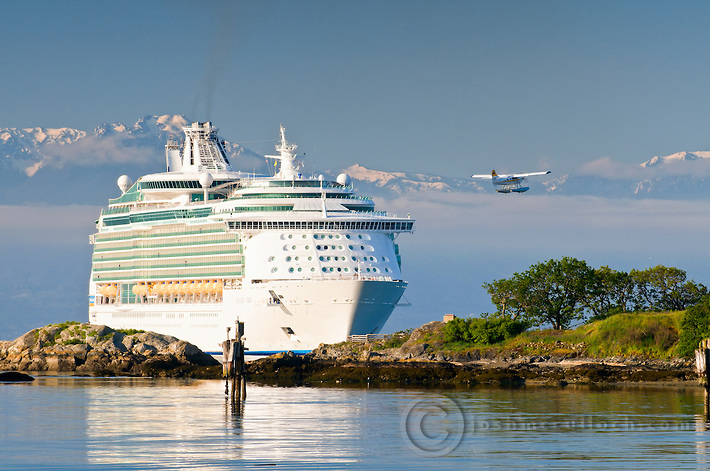 Saanich or the West Shore, nor any of the thousands of sailors from visiting US ships, spending their dollars in and around Esquimalt. When tourists arrive by ferry or air, their destination is most often the downtown area and while world-class tourist attractions such as the Butchart Gardens draw large crowds, they are mostly ‘in’ and ‘out’ patrons staying in the core.
Saanich or the West Shore, nor any of the thousands of sailors from visiting US ships, spending their dollars in and around Esquimalt. When tourists arrive by ferry or air, their destination is most often the downtown area and while world-class tourist attractions such as the Butchart Gardens draw large crowds, they are mostly ‘in’ and ‘out’ patrons staying in the core.
Photo (Web Source): This photo was taken from the West Bay Marina in Esquimalt. It shows a cruise ship entering the Victoria Harbour as a Harbour Air floatplane leaves. This is about as close as any of the 2000 or so passengers on that ship will ever get to Esquimalt.
Victoria is also the recipient of a massive influx of tax dollars from the daytime travel of government and business workers, as well as night-time restaurant and entertainment establishments who host tourists and locals alike. The price of gaining all those tax, tourist, business and entertainment dollars, is providing infrastructure, including a Police Department capable of handling that influx and the challenges that may pose. Seeking to lay off the responsibility to their Regional partners, is quite simply wrong. Victoria might suggest that following amalgamation, everyone could share in those dollars, but organizational imperatives would likely prevent that from ever happening.
In short, if the Victoria Police cannot handle the workload, as is strongly suggested by successive Chief Constables in their many press releases, they might wish to sign mutual aid agreements with Oak Bay, Saanich, and Central Saanich in order to help them cover the shortfalls in their service provision model. Esquimalt is already helping to offset some of the workload in the city. It seems likely that on a cost-sharing basis, other outside Departments might help to caulk up some of the holes in their service.
As for full amalgamation of the police, it does not take a visionary to realize the Victoria-Esquimalt debacle could easily be magnified many times in a Victoria PD controlled Regional system. Why any Police Chief, Mayor, Council Member or citizen in their right mind willingly to walk into that firestorm.
This brings us to the question of why it is only the police who are singled out in these discussions.
6. Full Amalgamation: A Greater Victoria Metropolitan Government
Across the region, there are firemen, inside and outside workers, recreation staff and dozens of other service agencies. There is also a baker’s dozen of Mayors and Councils. Why not amalgamate the entire region into one political entity1? A city of 350,000 is not that large? Let’s assume that at some point twenty or thirty years in the past, amalgamation had taken place and a Greater Victoria City Hall, managed the affairs of the region. Perhaps a ‘ward’ system was used in an attempt to distribute political power.
Do you suppose it would have been possible within a region controlled by a large central government to have transformed the Municipalities of View Royal and Langford as accomplished in recent years by Mayor Graham Hill or Mayor Stewart Young? Anyone who has travelled to the West Shore through those communities will see the very best in local area development as the citizens of those small municipalities drove for changes they perceived to be in the best interests of creating a livable community.
Can you imagine the ‘dog patch’ that was Langford as little as fifteen years back having had the political influence and business connections within a Metropolitan Government needed to transform their community into the absolute jewel it has become today? Not likely. The imperatives of a large city would have pushed development towards the central core if development was allowed. Some of you may recall why all those Big Box stores ended up in Langford.
For those behind the Tweed Curtain and under the stewardship of various Mayors, or in Saanich, under the long-term leadership of Mayor Frank Leonard; in Central Saanich, Esquimalt or other parts of the West Shore, would it have been possible to develop the amazing recreational and senior complexes as exist today? Not likely.
The list of accomplishments within each of the thirteen in the CRD, and that includes the City of Victoria in building the new arena and maintaining an amazing city core that is the envy of Canada, is almost endless. To the lasting credit of each, these improvements have been accomplished while living largely within their means, something that few amalgamated cities across Canada have been able to accomplish. Let’s pop across the water to Vancouver.
Greater Vancouver Regional District
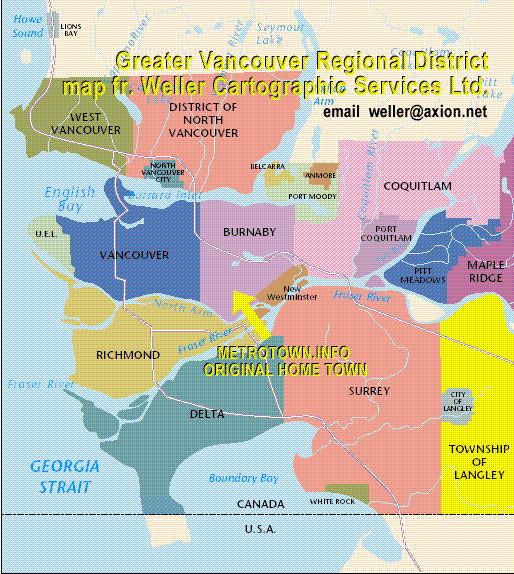 Another BC community that has an organizational structure very similar to Greater Victoria is the twenty-one cities and towns that comprise the GVRD, an area with a population that now exceeds 2.2 million.
Another BC community that has an organizational structure very similar to Greater Victoria is the twenty-one cities and towns that comprise the GVRD, an area with a population that now exceeds 2.2 million.
Like Greater Victoria, individual political entities within Greater Vancouver have made great advancements in infrastructure and, as well, have progressed with a number of joint ventures such as the building of a first-class rapid transit system.
The other thing they have in common is a mix of City, Municipal and RCMP police agencies. Is it the least bit surprising discussions concerning
the amalgamation of those forces continue to swirl about? Remember these are forces that are all much larger than the largest force in Greater Victoria, still, a few people think the only reasonable outcome for the GVRD is an even larger force.
I rather expect, in a final analysis, the twenty-one members that make up the GVRD give thanks, each day they were not forced to follow the route of Metropolitan Toronto or they too might now be living under crushing debt and facing the challenges that city. Recent surveys done in Metro Toronto suggest a vast majority would revert to the pre-amalgamation system, however, once the genie is out of the bottle, she can never return.
Can you imagine the massive disruption that would be caused by attempting to force amalgamation on Greater Vancouver or Victoria? No Provincial Government in their right mind, at least one that wanted to be elected again, would ever contemplate such an action. What needs to be done is to look at the ways and means to better serve the citizens of the CRD by joining services that can be easily joined. Oak Bay and Saanich have demonstrated one option. It is noted that Saanich and the West Shore Fire Departments now share a common dispatch system (notes below). These things make for progress not conflict in areas of common interest.
These matters deserve to be given attention by the print, radio and TV reporters of Greater Victoria, rather than continuing to ‘beat the dead horse’ of amalgamation as they have been doing for the past fifty years.1
Harold McNeill
Oak Bay PD (Retired)
November 2011
Updated: October 17, 2014
See also:
Footnote (November 25, 2011):
Toronto (November 25, 2011 update): Toronto is an excellent Canadian example of amalgamations gone awry. An assessment of the Toronto experience is provided in this article: Toronto: Amalgamation, Ten Years Later
1. Footnote: The Drums in History
In 1958, Dr. John Deutch was appointed Chairman of a Committee charged with the responsibility of studying the relative merits of amalgamating the City of Victoria and the Municipality of Saanich. In his report Dr. Deutch had this to say2:
“With regard to saving, it should be possible to achieve a reduction in general overhead costs fairly quickly by a sum approaching $100,000 through the elimination of duplication which could be dispensed with immediately, reduction in executive council expenses, reduction in temporary and part-time staffs, more intensive use of equipment ….. over a period of years, the complete elimination of duplications in overhead should result in savings of several hundreds of thousands of dollars per year.”
In support of his contentions, Dr. Deutch, an economist I believe, prepared several taxation tables.
The anti-amalgamationists on the other hand, quickly pointed out that many of the (outlying) Municipalities had no problem operating within the present system. Why, they ask, should a change be needed? An unsigned paper, obviously written by an Oak Bay resident, contains the following statement:
“The city had the opportunity to take in Oak Bay (prior to the 1906 incorporation when the population was 350), and threw it away, through lack of foresight. Now that we (Oak Bay) are almost fully developed, with excellent services to our people, why should the ratepayers of Oak Bay, who have paid for those services, and who have paid a premium price for property in the District, now be required, on account of these services and amenities, now be required to join a larger area, and have their (our) taxes increased to pay for similar services in other areas.”
What is different today, is that almost all discussions about amalgamation involve only the police and the discussion continues to be carried exclusively by the City of Victoria, the Victoria-based Times Colonist, and the Victoria Police. I may have missed an article, but in my recollection, not one of the other twelve municipalities that make up the GVRD has supported the Victoria position. Given the vitriolic nature of Victoria-Esquimalt discussions over the past few years, it is not hard to figure out why. For those not familiar with the area the following information is provided.
2. Status Quo, Amalgamation or Metropolitan Government, a term paper for Sociology 200 written by Harold McNeill (c1970). The Deutch papers which I accessed in the late 1960s or early 1970s, are likely still archived in one of the local libraries.
Cartoon Hit on Victoria
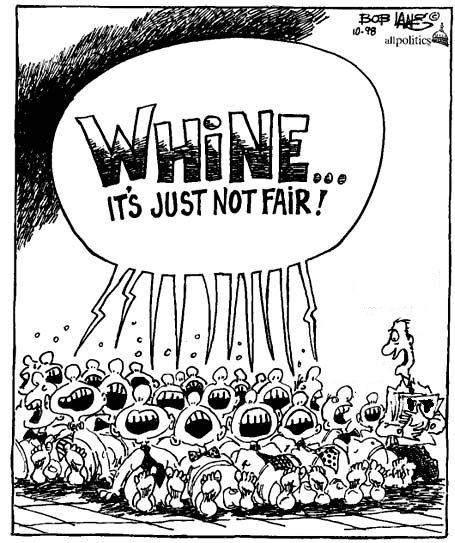
Cartoon, thanks to Bob Jang
Victoria, BC, October 15, 2011
(The following quotes are taken from a Times Colonist article by Jack Knox. The situation, however, is hypothetical)
Mayor Dean Fortin speaks at a rally of Victoria Police Department members in Centennial Square. The rally organizer, Chief Jamie Graham, is seated in the front row, third from right:
Mayor Fortin: “I’m frustrated on behalf of the citizens of Victoria and Esquimalt, and I’m frustrated on behalf of (you) men and woman of the Victoria Police Department, who have been serving both communities so well.”
After each statement Chief Graham leads his men in a rallying cry: “It’s just not fair, it’s just not fair…”.
The Mayor continues: “It’s time to stop re-arranging the chairs and say which ship should go. Let’s take a look at regionalization. Let’s take a look at bringing in a Greater Victoria police force – one that can address these issues in a fundamental way. What’s the right thing for our citizens?”
As the rally came to an end, Chief Graham stood and called his men to give three rousing “cheers” for the Mayor…). This pretty much says it all, as the Victoria Mayor, Chief of Police and a few business groups see amalgamation as only one thing – POLICE. They feel hard done by and make no bones about it. The Times Colonist, Victoria’s Newspaper (not the Capital Region) continues to push that point of view at every turn.
Then this cartoon (source unknown) looking at life for others after Amalgamation with Victoria
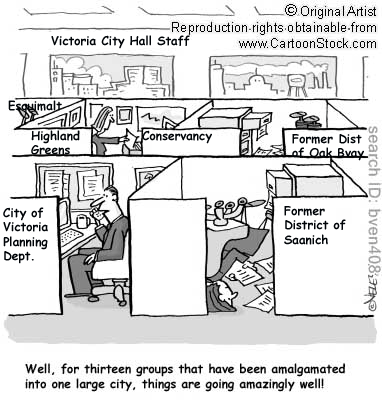
Victoria News by Erin McCracken A balanced article published on February 1, 1012. It has a link to a second article by Rozen Holmen, also with Victoria News.
January 25, 2012 Headline: Colwood and View Royal opt for Fire Dispatch service from Saanich (From My Tim Horton’s Morning Posts)
The above headline and article appear on page A3 of the Times Colonist this morning. Also, on Facebook this morning, Mayor Frank Leonard (Saanich), made this response to the headline:
“If you build it, they will come’ – We invested in first-class technology, building, and people – then put out the welcome mat – we don’t threaten our neighbors with takeovers – we simply offer first-class service to our customers.”
I fully support the Mayor. This is a much acceptable approach to integrating services within the CRD and leads to cooperation and problem-solving rather than conflict as does rattling sabres and making threats of take-over that so often emanate from our good neighbor Victoria.
2011 Census: Langford’s growth tops region
(Reference Times Colonist February 9, 2011)
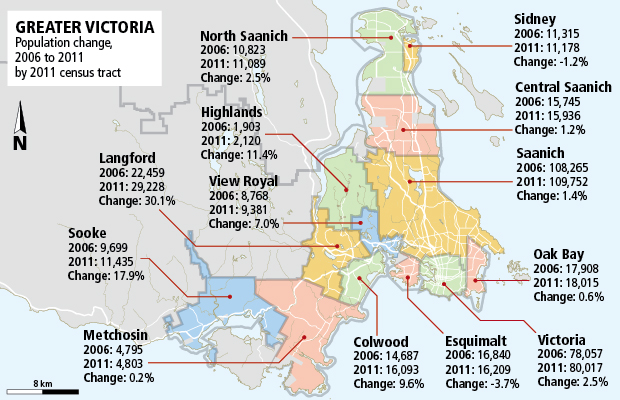
The phenomenal growth in Langford between 2006 and 2011, reflects a number of policy decisions made by respective Langford Councils over the past 20 years that has helped to propel the former “Dogpatch” (even the Mayor is now using the word) into the modern, livable community it is today. This would not have been the case if the future of Langford had been controlled by a City Council centred in the core area.
It will be very hard to convince the residents of Langford and other communities that their interests will be better served within an amalgamated city. Would it not work better to find the ways and means by which to work cooperatively in solving regional problems as presented in the area of sewer and water, public transportation, traffic congestion, public safety, etc?
Why Municipal Amalgamations Halifax, Toronto, Montreal
Link on the title above to full PDF. A paper was written by Andrew Sanction of the University of Western Ontario (2003, 27 page PDF). The paper provides excellent insight into the local, national and international pressures that drove many amalgamations within these cities and Provinces. There was never any rationale behind the push other than someone (a Premier and a few politicians) pushing amalgamation for political ends.
In none of the cases of forced amalgamation within those three provinces was any information ever developed or produced that would demonstrate the amalgamations would provide new efficiencies, streamlining of services or some other advantage that could not be more easily found by working at coordinating the efforts the individual entities that comprised these three cities as well as others discussed within the paper.
It also discussed experiences with a few amalgamations within the United States and other parts of the world. I some cases, for instance, in California, there is now a strong movement to try to disentangle the amalgamated cities.
The final paragraph of the paper reads:
“There are no sweeping conclusions to be drawn from this attempt to understand why municipal amalgamation policies have been pursued in Nova Scotia, Ontario, and Quebec over the last ten years. Such policies were brought in with little or no thought by provincial premiers who acted as they did in response to the particular political circumstance in which they found themselves. They made little or no effort to mobilize consent for these policies beyond a small group of cabinet ministers who in turn helped and control obedient caucuses. The adoption of these policies demonstrates how easy it is – in some circumstances at least – for those who control the apparatus of the provincial state to have their way. Such a demonstration raises two questions: Is it a good idea for provincial premiers to be able to do what they want without having to mobilize political support? Or is the municipal sector in some way unique or unusual, such that similar state policy-making autonomy would not be possible in other sectors.”
Final Note
Within British Columbia, we had a small taste of this process when former Premier Campbell and his Finance Minister pushed through the HST without first gaining any form of support within their own government or of the people. While the idea might have had some merit, it turned out to be a very costly error on the part of the government. Hopefully, the same error will not be made with respect to amalgamation in Greater Victoria as they are now finding was made in some of the large eastern cities.
(7186)
Tags: Capital Regional District, Chief Jamie Graham, CRD, Dr. John Deutch, Esquimalt, Frank Leonard, Graham Hill, Greater Vancouver Regional District, GVRD, Harold McNeill, Jack Knox, Katie DeRosa, Lindsay Kines, Mayor Dean Fortin, Oak Bay, Rob Shaw, Saanich, Stewart Young, Victoria City Police, Victoria Police
Trackback from your site.


Comments (1)
Can I interest you in getting involved with the Amalgamation Project?
http://amalgamationproject.ca/